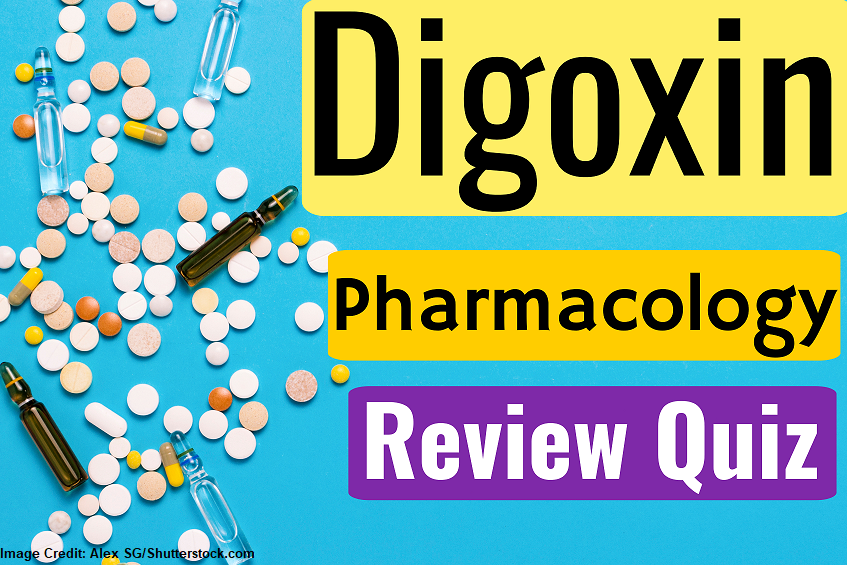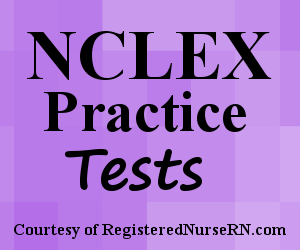Digoxin NCLEX questions for nursing students!
Digoxin is a medication used to help the heart pump more efficiently, and it is used for many cardiac conditions. The nurse should be aware of how the drug works, why it is ordered, nursing implications, signs and symptoms of toxicity, and how to teach the patient how to take the medication.
Don’t forget to what the lecture on digoxin nursing pharmacology before taking the quiz.
This quiz is part of a pharmacology NCLEX question review series and will include various medications. This series will test your knowledge on nursing implications, side effects, patient teaching, therapeutic effects, and more.

Digoxin NCLEX Questions (Lanoxin)
This quiz contains NCLEX review questions on the medication Digoxin (Lanoxin).
(NOTE: When you hit submit, it will refresh this same page. Scroll down to see your results.)
Digoxin NCLEX Questions
1. Digoxin is part of what family of drugs?
A. Angiotensin-converting enzyme inhibitors
B. Beta-blockers
C. Angiotensin II receptor blockers
D. Cardiac glycosides
The answer is D: cardiac glycosides
2. Digoxin helps the heart pump more efficiently by altering the inotropic, chronotropic, and dromotropic actions of the heart. Select all the options below that accurately describe these actions created by Digoxin:
a. Positive Chronotropic
b. Positive Inotropic
c. Negative Inotropic
d. Negative Dromotropic
e. Negative Chrontropic
f. Positive Dromotropic
The answers are: B, D, and E. Digoxin creates a positive inotropic, negative chronotropic, and negative dromotropic action on the heart. This helps the heart’s contraction to be stronger while it pumps at a slower rate. Therefore, the heart will empty more efficiently (less back flow of blood) and this will increase stroke volume, which will increase cardiac output.
3. A patient is taking Digoxin. What medication on the patient’s medication list increases the patient’s risk of experiencing Digoxin toxicity?
A. Furosemide
B. Metformin
C. Nitroglycerin
D. Coumadin
The answer is A. Furosemide is a loop-diuretic and this medication wastes potassium. Remember hypokalemia (low potassium level) increases the risk of a patient developing Digoxin toxicity. Hypercalcemia (>10.2 mg/dL) and hypomagnesemia ( < 1.5 mg/dL)also increases Digoxin toxicity.
4. Your patient, who is 55-years-old, is prescribed to take Digoxin. What patient finding requires that the nurse hold the dose of Digoxin and notify the physician?
A. Digoxin level of 1.2 ng/mL
B. Blood glucose 82
C. Heart rate 61 bpm
D. Potassium 2.8 mEq/L
The answer is D. The patient’s potassium level is low (<3.5 mEq/L). Remember hypokalemia increases the chances of Digoxin toxicity developing. The nurse should notify the MD and hold the ordered dose until further instructions are given by the doctor.
5. What is the therapeutic range of the drug Digoxin?
A. 2-3.5 ng/mL
B. 0.1-2 ng/mL
C. 0.5-2 ng/mL
D. 3.5-5 ng/mL
The answer is C. A normal Digoxin level should be 0.5 – 2 ng/mL. Any levels greater than 2 ng/mL is considered toxic.
6. An adult patient is being discharged home on Digoxin. Which statements below verbalized by the patient demonstrates they understand how to properly take this medication? Select all that apply:
A. “I will limit by intake of foods high in potassium.”
B. “I will not take this medication and notify the physician if my heart rate is less than 70 bpm.”
C. “I will measure my pulse rate before every dose I take.”
D. “It is important that I immediately report any vision changes I may experience while taking this medication.”
The answers are C and D. The patient should always measure their pulse rate before taking each dose of Digoxin and hold the dose if it is less than 60 bpm (this is for adults). The patient should not restrict foods high in potassium because this could lead to hypokalemia, which can lead to Digoxin toxicity. Vision changes should be reported because this could indicate Digoxin toxicity.
7. What EARLY signs and symptoms should the nurse assess for in a patient taking Digoxin that could indicate toxicity of this drug? Select all that apply:
A. Dysrhythmias
B. Anorexia
C. Drowsiness
D. Nausea
E. Vomiting
The answers are B, D, and E. GI-related signs and symptoms are the earliest indications that the patient may be having Digoxin toxicity. The other signs and symptoms occur later, especially dysrhythmias.
8. An infant is ordered a scheduled dose of Digoxin. The patient’s apical pulse rate is 78 bpm. The nurse would:
A. Administer the dose as ordered
B. Hold the dose and reassess the apical pulse rate in 1 hour
C. Skip this dose but administer the next scheduled dose
D. Hold the dose and notify the physician
The answer is D. The nurse should hold a dose of Digoxin and notify the physician if the INFANT’S heart rate is less than 90-110 bpm.
9. Which patient below is at MOST risk for developing Digoxin toxicity?
A. A 30-year-old male patient with heart failure and hyperglycemia
B. A 82-year-old male patient with atrial fibrillation and magnesium level of 1 mg/dL.
C. A 45-year-old female with potassium level of 4.2 mEq/L.
D. A 50-year-old female with a calcium level of 9 mg/dL.
The answer is B. Elderly patients are at a very high risk of Digoxin toxicity due to a decrease of function in the liver and renal system. Also, this patient in option B is experiencing hypomagnesemia (<1.5 mg/dL) which increases the risk of Digoxin toxicity even more.
More NCLEX Quizzes
Don’t forget to tell your friends about this quiz by sharing it your Facebook, Twitter, and other social media. You can also take more fun nursing quizzes.
*Disclaimer: While we do our best to provide students with accurate and in-depth study quizzes, this quiz/test is for educational and entertainment purposes only. Please refer to the latest NCLEX review books for the latest updates in nursing. This quiz is copyright RegisteredNurseRn.com. Please do not copy this quiz directly; however, please feel free to share a link to this page with students, friends, and others.
